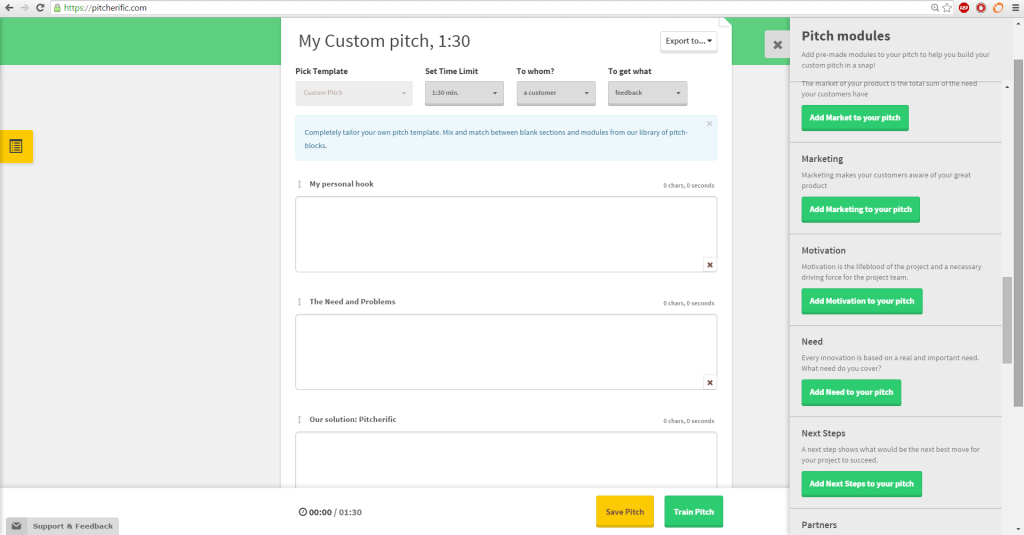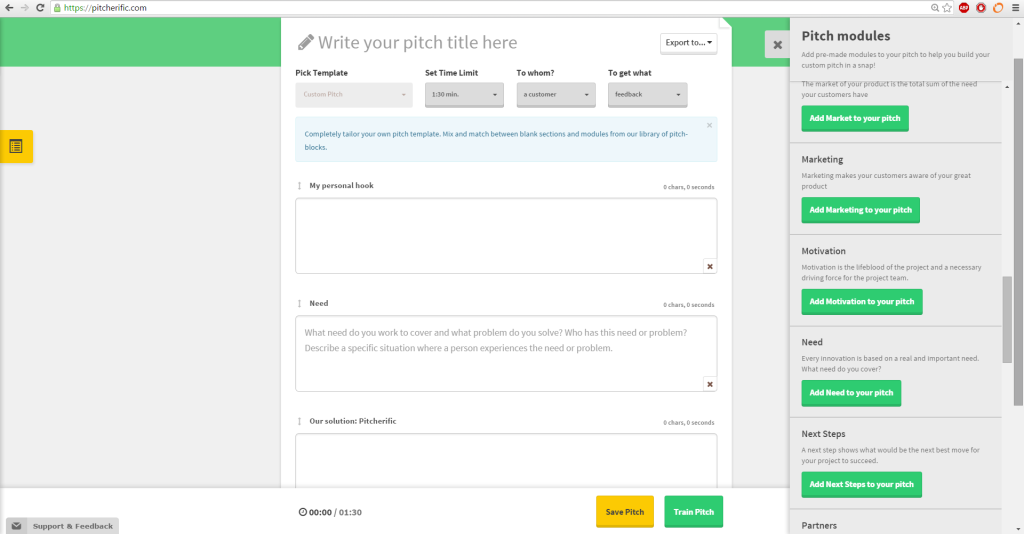Best practice templates or customized pitches?
On Pitcherific we use best practice pitch templates in order to make preparing a pitch fast and easy, such as an elevator pitch, or the NABC template that focuses on potential clients or investors.
If you’re new to the discipline of pitching, you would probably get the most out of one of our pre-defined pitch templates. It gets you started quickly, so you can get out and pitch as soon as possible.
Nevertheless, a time comes when you have more experience with presenting your idea or product. You might do it more regularly and discover that one pitch does not fit all. Many entrepreneurs eventually discover their very own pitch style and that’s when you might need something more than a template. You need something more “tailor-made”.
In our PRO version of Pitcherific, our users can tailor-make their pitch completely like they want. If they discover that talking about the competition before their product benefits works better, they just drag the sections around and re-order them. If they want to rename a section, they just click on it and write something better.
Building your pitch in no time
In our custom pitch builder, you can tailor your pitch completely from scratch and define any different subjects you want to talk about, like need, target audience, the idea, *the business model and so on. Alternatively you can make use of the pre-defined subjects we’ve added to a huge library. They work a bit like LEGOs where you can quickly add different pitch subjects in no time.
Screenshot 1: I’ve just begun on my custom pitch and added three sections
Screenshot 2: I’ve written some content to my custom pitch and name it “My custom pitch 1:30”.
Another advantage of using these ‘LEGOs’ from the library, apart from being an inspiration to the content of your pitch, is that they give you helpful instructions and questions that can guide you when writing your pitch.
A few tips to your custom pitch
Whether you’re building your pitch freely or if you find inspiration in our subject library, I want to share a few tips on building your pitch here.
These advice are pretty general and useful whether you’re pitching an idea, a product or your business and you target audience is colleagues, customers or investors.
In a simplified way, a good pitch consists of three elements. An introduction (a hook), a core message and an ending (a close). When you’re choosing content (subjects) for you core message it’s a good idea to keep in mind who you’re pitching to, what you wish to gain from your pitch and whether the situation comes with some constraints to you, like time limits at a competition.
You can read more about these 3 things to remember before you pitch in this article “3 things you need to do before writing your pitch” and you can read more about why the core message is so important in “The idea is the foundation of your pitch”.
Remember that even if you probably can – and really want to – tell everyone about all the details behind your great idea or product, it’s best to wait with most details or additional messages to later occasions. They usually fit better at a follow-up meeting or in an email.
Add a captivating hook and a memorable ending
It’s always a good idea to create a captivating hook when you pitch. The point about a hook is, like the name implies, to catch the interest of your audience and get a good start. You can read about the different kinds of hooks in this article: “Capture your audience – create a captivating hook”.
It’s also important that you end your pitch confidently, for example by explaining the next steps of your project or by doing a call-to-action, where you motivate your audience to take action in some way.
I hope that giving you this brief overview of how you make a great, tailor-made pitch will inspire you to try to make a pitch that fits you and your situation perfectly.
And remember: When you’ve made a custom pitch you can always add new sections, re-order them or remove them. It’s all up to you!




